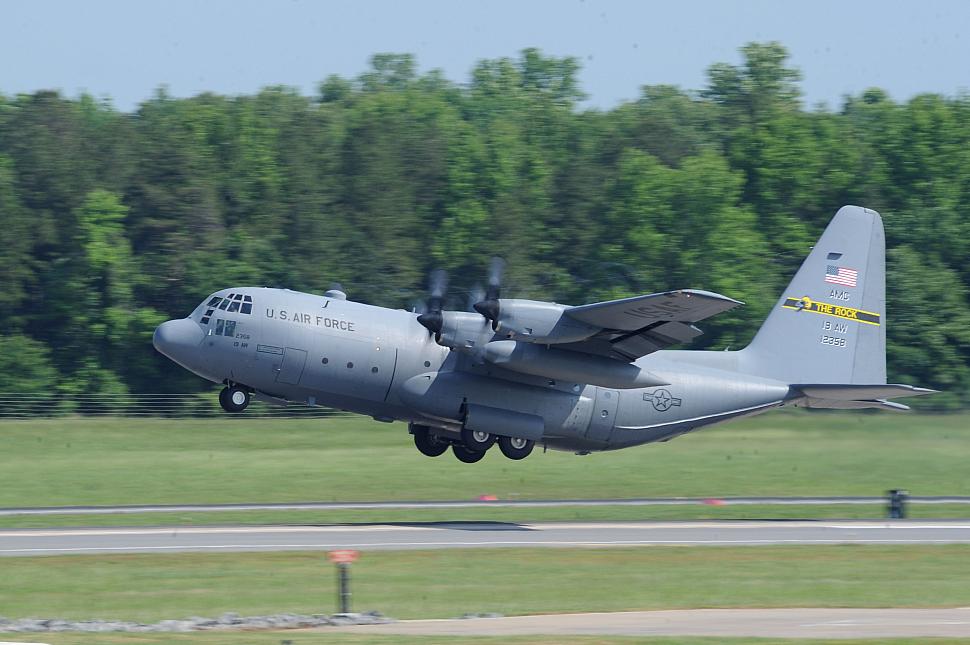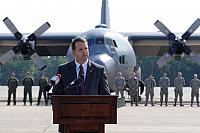C-130 News
C-130 Hercules News
Legacy aircraft, last of its kind, honored at the Rock
May 1, 2012 (by
SSgt. Jacob Barreiro) -
The propeller blades were cycling in synchronization as the dedicated crew chief stood in front of the nose of the aircraft, rubbing it in cyclical fashion, jocularly encouraging the blades to keep turning. As the crew chiefs backed off and gave the "thumbs up" to the aircrew, the C-130E began to taxi down the runway on the flight line at Little Rock Air Force base, Ark., and took off to the sky. C-130s soaring through the air is a common sight for citizens of the base and its surrounding area, but this was anything but a common flight.

When the plane turned down the runway, a crowd comprised of leaders and Airmen from three different wings, civic leaders in the community and the Air Mobility Command Command Chief Master Sergeant stood up to wave goodbye, and their waves were reciprocated by the plane's crew before it was christened by water spurting from fire trucks.
The people were assembled and waving because this plane, and day, was special. The day, May 1, 2012, was the day Team Little Rock said goodbye to tail number 61-2358, the first C-130E model plane to be produced by Lockheed Martin, and the last of its kind to be retired.
"This plane represents a milestone in the history of the C-130 and the history of the Air Force," said Col. Brian Robinson, 19th Airlift Wing commander. "This is the most capable, tough as nails aircraft, and it's been to every remote corner of the planet, including Antarctica."
Robinson said the C-130 has a distinguished heritage that began at Little Rock, so it was only fitting that the base hosted the retirement of such an important plane.
The first operational mission flown by a C-130 was on Sept. 24, 1957, by the mandate of President Dwight Eisenhower, to airlift 1,200 paratroopers to enforce the desegregation of Little Rock Central High School. The mission was carried off successfully, the first of millions to be performed by C-130s around the world.
Robinson said 2358 has done its share to contribute to the C-130 legacy.
"She never rested, she did her mission to the end," said Robinson.
The plane left Little Rock May 1, to fly to Edwards Air Force Base, Calif., where it will be a static display.
Fred Ross, vice president of C-130 programs at Lockheed Martin, said 2358 had a distinguished career, from its first flight to its twilight run to retirement.
"C-130s always carry the load," he said. "One thing you all at Little Rock understand is combat airlift, and that's defined by the C-130."
Ross said the plane's five decades in the sky is a rare sight, and that no other aircraft has been in continuous production for 57 years, like the C-130.
2358 is the last of the C-130E models to be retired from the active duty fleet, and is slated to be replaced by the newer J models. The J models are a huge leap in technology, Ross said, but will still be a Hercules in the C-130 tradition, a tradition exemplified by 2358.
"I'm proud of 2358 ... it's been involved in humanitarian airlift all over the world and contributed numerous air drops in the lands of Afghanistan and Iraq ... most of all I'm proud it was built for you and served you well for more than 50 years."
Robinson said the retirement of 2358 was a great occasion to celebrate the history of combat airlift, and to also recognize the efforts of the local community.
"Today we not only recognize those who fly and maintain our aircraft but also the local community and their leaders," he said. "Without your support these planes would not fly."
The legacy of the C-130 will be carried on in the future by the C-130J models, said Robinson. The C-130J is an innovative airlifter, inspired by the Marine Corps, equipped with offensive capabilities.
"Not only will we be able to deliver cargo and air drops all over the world, we will also be able to help our brothers and sisters in need in other ways now, too," he said.
As the plane taxied down the Rock's flight line for the final time, and lifted off the ground, the crowd once again waved goodbye. They waved goodbye to a paragon of its kind, a workhouse that put in more than 50 years of service, but as they waved and the plane lifted into the sky, the sun shone bright, and the future looks bright for C-130s and combat airlift.

C-130E #61-2358 takes off from the base flight line for the last time, May 1, 2012, at Little Rock AFB. [USAF photo by TSgt. Chad Chisholm]
The people were assembled and waving because this plane, and day, was special. The day, May 1, 2012, was the day Team Little Rock said goodbye to tail number 61-2358, the first C-130E model plane to be produced by Lockheed Martin, and the last of its kind to be retired.
"This plane represents a milestone in the history of the C-130 and the history of the Air Force," said Col. Brian Robinson, 19th Airlift Wing commander. "This is the most capable, tough as nails aircraft, and it's been to every remote corner of the planet, including Antarctica."
Robinson said the C-130 has a distinguished heritage that began at Little Rock, so it was only fitting that the base hosted the retirement of such an important plane.
The first operational mission flown by a C-130 was on Sept. 24, 1957, by the mandate of President Dwight Eisenhower, to airlift 1,200 paratroopers to enforce the desegregation of Little Rock Central High School. The mission was carried off successfully, the first of millions to be performed by C-130s around the world.
Robinson said 2358 has done its share to contribute to the C-130 legacy.
"She never rested, she did her mission to the end," said Robinson.
The plane left Little Rock May 1, to fly to Edwards Air Force Base, Calif., where it will be a static display.
Fred Ross, vice president of C-130 programs at Lockheed Martin, said 2358 had a distinguished career, from its first flight to its twilight run to retirement.
"C-130s always carry the load," he said. "One thing you all at Little Rock understand is combat airlift, and that's defined by the C-130."
Ross said the plane's five decades in the sky is a rare sight, and that no other aircraft has been in continuous production for 57 years, like the C-130.
2358 is the last of the C-130E models to be retired from the active duty fleet, and is slated to be replaced by the newer J models. The J models are a huge leap in technology, Ross said, but will still be a Hercules in the C-130 tradition, a tradition exemplified by 2358.
"I'm proud of 2358 ... it's been involved in humanitarian airlift all over the world and contributed numerous air drops in the lands of Afghanistan and Iraq ... most of all I'm proud it was built for you and served you well for more than 50 years."
Robinson said the retirement of 2358 was a great occasion to celebrate the history of combat airlift, and to also recognize the efforts of the local community.
"Today we not only recognize those who fly and maintain our aircraft but also the local community and their leaders," he said. "Without your support these planes would not fly."
The legacy of the C-130 will be carried on in the future by the C-130J models, said Robinson. The C-130J is an innovative airlifter, inspired by the Marine Corps, equipped with offensive capabilities.
"Not only will we be able to deliver cargo and air drops all over the world, we will also be able to help our brothers and sisters in need in other ways now, too," he said.
As the plane taxied down the Rock's flight line for the final time, and lifted off the ground, the crowd once again waved goodbye. They waved goodbye to a paragon of its kind, a workhouse that put in more than 50 years of service, but as they waved and the plane lifted into the sky, the sun shone bright, and the future looks bright for C-130s and combat airlift.
Related articles:
Forum discussion:
Tags
Forum discussion:
- Start a discussion about this article in the C-130.net forum.
Tags


